Buttress thread
The buttress thread form, also known as the breech-lock thread form,[1] refers to two different thread profiles. One is a type of leadscrew and the other is a type of hydraulic sealing thread form. The leadscrew type is often used in machinery and the sealing type is often used in oil fields. The asymmetric thread form allows the thread to have low friction and withstand greater loads than other forms in one direction, but at the cost of higher friction and inferior load bearing in the opposite direction.
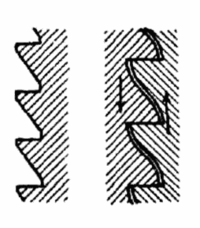
Buttress thread in machinery
In machinery, the buttress thread form is designed to handle extremely high axial thrust in one direction. The load-bearing thread face is perpendicular to the screw axis.[2] or at a slight slant (usually no greater than 7°)[3] The other face is slanted, often at 45°. The resulting thread form has the same low friction properties as a square thread form but at about twice the shear strength due to the long thread base. This thread form also is easy to machine on a thread milling machine, unlike the difficult to machine square thread form. It can also compensate for nut wear using a split nut, much like the Acme thread form.[4]
Buttress threads have often been used in the construction of artillery, particularly with the screw-type breechblock.[1] They are also often used in vises, because great force is only required in one direction.[4]
It is obvious on inspection that a buttress thread with perpendicular face, operating in a split nut, generates minimal disengagement force when tightened in the normally loaded direction, and thus it is possible to derive quick release devices to, for example, allow rapid repositioning of the movable jaw of a vise without having to rotate the screw by many turns. A screw profile, such as acme, where the thrust face is not perpendicular to the axis, generates a significant disengagement force on a split nut, therefore a more robust controlling mechanism would be required. Quick release vices are readily available. It is not known whether any of them are currently using buttress screws. An expired patent for a clamp using a buttress thread exists and this article describes a vise whose screw thread is disengaged by reverse rotation, which is likely to use a buttress thread, however no currently manufactured devices of that nature have been found at this time (October 2018).
Types
The image gallery below shows some of the types of buttress threads.
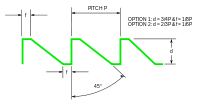 Simple buttress thread form[5]
Simple buttress thread form[5]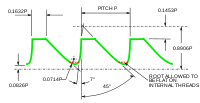 The ANSI 45°/7° buttress thread form[6]
The ANSI 45°/7° buttress thread form[6]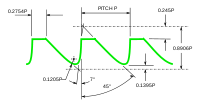 The British 45°/7° buttress thread form[7]
The British 45°/7° buttress thread form[7]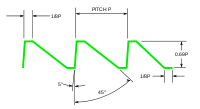 The 45°/5° buttress thread form[5]
The 45°/5° buttress thread form[5]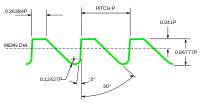 The 33°/3° German "Sägegewinde" (saw tooth) buttress thread form[5]
The 33°/3° German "Sägegewinde" (saw tooth) buttress thread form[5]
Mechanics
Buttress thread in oil field tubing
In oil field tubing, buttress thread is a pipe thread form designed to provide a tight hydraulic seal. The thread form is similar to that of Acme thread[8][9] but there are two distinct threaded portions of differing diameters and profiles, the larger having a wedging profile, with a tapered sealing portion in between the larger and smaller diameters. High torque may be transmitted and longitudinal force is transmitted almost parallel to the axis. The thread is about the same strength as standard v threads.
See also
References
- French, Thomas Ewing (1918-01-01). A Manual of Engineering Drawing for Students and Draftsmen. McGraw-Hill book Company, Incorporated.
- Barnwell, p. 163.
- US patent 5127784, David Eslinger, "Fatigue-resistant buttress thread", issued 1992-07-07
- Bhandari, p. 204.
- Oberg, p.1817
- Oberg, pp. 1819–1820.
- Timings, p. 127.
- US patent 6893057, M. Edward Evans, "Threaded pipe connection", issued 2005-05-17 Figure 6.
- Oil field glossary entry for buttress thread
Bibliography
- Barnwell, George W. (1941), The new encyclopedia of machine shop practice, Wm. H. Wise & Company.
- Bhandari, V B (2007), Design of Machine Elements, Tata McGraw-Hill, ISBN 978-0-07-061141-2.
- Oberg, Erik; Jones, Franklin D.; Horton, Holbrook L.; Ryffel, Henry H. (2000), Machinery's Handbook (26th ed.), New York: Industrial Press Inc., ISBN 0-8311-2635-3.
- Timings, Roger Leslie (2005), Newnes Mechanical Engineer's Pocket Book (3rd ed.), Newnes, ISBN 978-0-7506-6508-7.